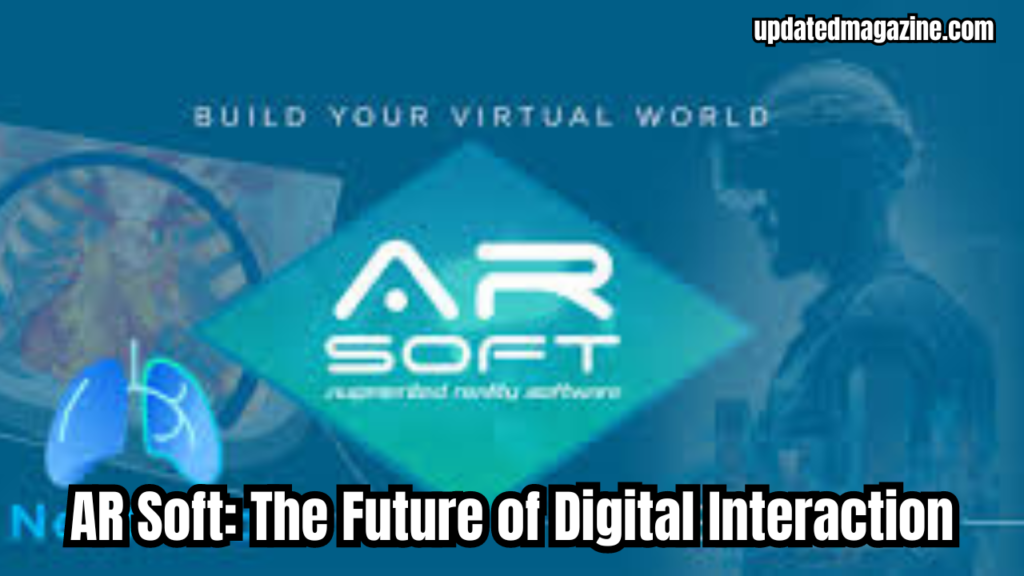Introduction
AR Soft refers to software that leverages Augmented Reality (AR) technology to enhance the real-world environment with digital overlays, interactive elements, and immersive experiences. This type of software is used across various industries, including gaming, education, healthcare, and retail, to create engaging and interactive applications. AR Soft enables users to interact with virtual objects in real-time through devices such as smartphones, tablets, or AR glasses, offering a blend of physical and digital experiences that can transform how we perceive and interact with the world around us.
A Comprehensive Overview
AR Soft refers to software solutions designed specifically to integrate augmented reality into various applications. These solutions range from mobile apps to enterprise systems, offering immersive experiences by overlaying digital content onto the real world. AR Soft enables users to interact with digital elements in real-time, enhancing the perceived reality through visual, auditory, and sensory overlays.
The Evolution of Augmented Reality Technology
Augmented Reality has come a long way since its inception. The early stages of AR technology focused on basic overlays of text and images on static backgrounds. Over time, advancements in hardware and software have allowed AR to become more dynamic and interactive. AR Soft represents the latest in this evolution, leveraging powerful algorithms and high-performance graphics to create seamless integrations between the digital and physical worlds.
Key Features of AR Soft Solutions
AR Soft stands out due to its unique features that offer a superior user experience. These include real-time interaction, precise object tracking, and high-quality graphics rendering. Moreover, AR Soft supports multi-platform integration, allowing users to access augmented reality experiences on various devices, from smartphones to AR headsets. The software also features advanced spatial mapping, enabling digital content to interact more naturally with the physical environment.
Applications of AR Soft in Various Industries
AR Soft’s versatility allows it to be applied across multiple industries. In retail, it enables virtual try-ons and immersive product demonstrations, enhancing customer engagement. In education, AR Soft transforms traditional learning methods by offering interactive and visual aids that make complex subjects more accessible. The healthcare sector benefits from AR Soft through enhanced medical training and patient care applications, while the gaming industry continues to push the boundaries of immersive experiences with AR-driven gameplay.
How AR Soft Transforms Customer Experiences
AR Soft revolutionizes customer experiences by making interactions more engaging and personalized. For instance, in the retail sector, AR Soft allows customers to visualize products in their own environment before making a purchase, reducing uncertainty and boosting confidence. This technology also supports interactive advertisements, where customers can engage with products in a virtual space, leading to higher conversion rates and customer satisfaction.
Developing AR Soft: The Technical Aspects
Creating AR Soft solutions requires a deep understanding of both software development and augmented reality technologies. Developers need to work with 3D modeling, computer vision, and spatial computing to create realistic and responsive AR experiences. The development process often involves collaboration between designers, engineers, and UX specialists to ensure the software not only functions well but also offers an intuitive and enjoyable user experience.
Challenges in AR Soft Development
Despite its potential, developing AR Soft presents several challenges. Ensuring compatibility across different devices and platforms can be difficult due to varying hardware capabilities. Additionally, creating smooth and responsive AR experiences requires significant computational power, which can strain device resources. Developers must also address issues related to user privacy and data security, as AR applications often require access to sensitive information such as location data.
AR Soft and the Role of Artificial Intelligence
Artificial Intelligence (AI) plays a crucial role in enhancing AR Soft solutions. AI algorithms enable more accurate object recognition and tracking, allowing digital content to interact more naturally with the physical environment. Machine learning models improve the responsiveness of AR applications, adapting to user behaviors and preferences over time. AI also supports the development of more sophisticated and personalized AR experiences, making AR Soft an indispensable tool in modern digital interaction.
The Future of AR Soft: Trends and Predictions
The future of AR Soft looks promising, with several trends indicating its continued growth and evolution. One major trend is the integration of AR with other emerging technologies, such as 5G and IoT, which will enable more complex and interactive experiences. Another trend is the increased focus on enterprise applications, where AR Soft will play a key role in areas like remote collaboration, training, and data visualization. As AR technology becomes more accessible, we can expect to see a broader range of applications and a deeper integration into everyday life.
AR Soft in Retail: Enhancing the Shopping Experience
In the retail industry, AR Soft transforms the shopping experience by bridging the gap between online and offline worlds. Virtual try-ons allow customers to see how products like clothing, accessories, or even furniture would look in real life. AR Soft also supports interactive product displays in physical stores, where customers can access detailed information and reviews simply by pointing their device at an item. This seamless integration of digital and physical retail enhances customer engagement and drives sales.
AR Soft in Education: A New Era of Learning
Education stands to benefit significantly from AR Soft solutions. Traditional teaching methods often struggle to engage students, especially in subjects that require visual and spatial understanding. AR Soft addresses this challenge by providing interactive and immersive learning experiences. For example, students can explore historical events in 3D, interact with complex biological structures, or practice problem-solving in a simulated environment. AR Soft makes learning more engaging and effective, catering to various learning styles.
AR Soft in Healthcare: Revolutionizing Medical Training and Patient Care
In healthcare, A R Soft offers innovative solutions that enhance both medical training and patient care. Medical professionals can use AR to simulate surgeries, practice complex procedures, and visualize patient data in real-time. A R Soft also supports patient education, allowing doctors to explain conditions and treatments more effectively by overlaying digital information onto physical models or even the patient’s body. This technology improves the accuracy of diagnoses and treatments, leading to better patient outcomes.
AR Soft in Gaming: Creating Immersive Worlds
The gaming industry has long been a pioneer in adopting new technologies, and A R Soft is no exception. A R Soft enables the creation of immersive and interactive game worlds, where players can engage with digital elements that seamlessly blend with their real environment. This level of immersion offers a unique gaming experience that traditional games cannot match. As AR technology continues to evolve, we can expect even more innovative and engaging games that push the boundaries of what’s possible.
AR Soft in Real Estate: Visualizing Properties in 3D
The real estate industry also benefits from A R Soft, which allows potential buyers to visualize properties in 3D before making a decision. Real estate agents can use A R Soft to create virtual tours, where clients can explore properties as if they were physically there. This technology helps buyers make more informed decisions, reducing the need for multiple physical visits and speeding up the sales process. A R Soft also enables the customization of properties, where buyers can visualize different design options in real-time.
The Impact of AR Soft on Marketing and Advertising
Marketing and advertising have always relied on innovation to capture the attention of consumers. AR Soft offers a new avenue for marketers to create engaging and memorable campaigns. By incorporating augmented reality into advertisements, brands can create interactive experiences that resonate with consumers. For example, an AR advertisement might allow users to see how a product would look in their home or interact with a virtual version of the product. These immersive experiences drive higher engagement and increase the likelihood of conversion.
AR Soft and User Privacy: Balancing Innovation with Security
While A R Soft offers numerous benefits, it also raises concerns about user privacy and data security. AR applications often require access to sensitive information, such as location data and camera feeds, which can be exploited if not properly secured. Developers must implement robust security measures to protect user data and ensure that AR experiences remain safe and trustworthy. Transparency about data usage and obtaining explicit user consent are also crucial in maintaining user trust and confidence in A R Soft solutions.
AR Soft and Accessibility: Ensuring Inclusive Experiences
Accessibility remains a critical consideration in the development of AR Soft solutions. To ensure that AR experiences are inclusive, developers must consider the needs of users with disabilities. This includes providing alternative inputs for users who may not be able to interact with AR content through traditional means, such as touch or gesture controls. Additionally, AR Soft should support features like text-to-speech and visual contrast adjustments to accommodate users with visual or auditory impairments. By prioritizing accessibility, A R Soft can create inclusive experiences that benefit a broader audience.
The Role of AR Soft in Remote Work and Collaboration
The rise of remote work has highlighted the need for effective collaboration tools, and A R Soft provides innovative solutions in this area. A R Soft enables remote teams to collaborate in a shared virtual space, where they can interact with digital models, documents, and each other in real-time. This technology supports more engaging and productive meetings, where participants can visualize ideas and concepts in 3D, regardless of their physical location. A R Soft also facilitates remote training and onboarding, providing interactive and immersive learning experiences for new employees.
How Businesses Can Leverage AR Soft for Competitive Advantage
Businesses across various industries can leverage AR Soft to gain a competitive advantage. By integrating augmented reality into their operations, companies can enhance customer experiences, improve employee training, and streamline processes. For example, manufacturers can use A R Soft for real-time equipment monitoring and maintenance, reducing downtime and increasing efficiency. Retailers can offer personalized shopping experiences that drive customer loyalty and increase sales. In every case, A R Soft provides businesses with the tools they need to innovate and stay ahead of the competition.
AR Soft Development Tools and Platforms
Developers looking to create A R Soft solutions have access to a wide range of tools and platforms. Popular AR development platforms include Unity and Unreal Engine, both of which offer powerful tools for creating immersive AR experiences. These platforms support a variety of devices, from smartphones to AR headsets, and provide developers with the flexibility to create customized solutions for different industries. Additionally, A R Soft development often involves the use of specialized SDKs, such as ARKit for iOS and ARCore for Android, which simplify the integration of AR features into mobile applications.
AR Soft in the Automotive Industry: Enhancing Safety and Navigation
The automotive industry has embraced A R Soft as a means of enhancing safety and navigation. AR head-up displays (HUDs) project critical information, such as speed, navigation directions, and hazard warnings, directly onto the windshield, allowing drivers to stay focused on the road. This technology reduces the need for drivers to glance at traditional displays, improving reaction times and overall safety. A R Soft also supports advanced driver-assistance systems (ADAS), where augmented reality provides real-time information about road conditions, obstacles, and other vehicles.
AR Soft and Smart Cities: Building the Future
Smart cities represent the future of urban development, and AR Soft plays a key role in their realization. By integrating augmented reality with IoT and other smart technologies, A R Soft enables city planners and residents to interact with urban environments in new and meaningful ways. For example, A R Soft can provide real-time information about traffic conditions, public transportation, and local amenities, making it easier for residents to navigate the city. Additionally, A R Soft supports smart infrastructure management, where city officials can monitor and maintain public assets more efficiently.
Investing in AR Soft: Opportunities and Risks
Investing in A R Soft presents both opportunities and risks. As augmented reality continues to gain traction, companies involved in AR Soft development stand to benefit from increased demand and market growth. However, the rapidly evolving nature of the technology also presents risks, including the potential for obsolescence and the challenges of staying ahead of competitors. Investors must carefully consider the long-term potential of AR Soft solutions and the ability of companies to innovate and adapt to changing market conditions.
AR Soft in Sports and Entertainment: Engaging Audiences in New Ways
The sports and entertainment industries have started to explore the potential of A R Soft to engage audiences in new and exciting ways. In sports, A R Soft enables fans to interact with live events through augmented reality overlays that provide real-time statistics, player information, and replays. This technology enhances the viewing experience, making it more immersive and interactive. In entertainment, AR Soft allows artists and performers to create unique and memorable experiences, where audiences can engage with digital content that complements live performances.
The Global Market for AR Soft: Growth and Trends
The global market for A R Soft continues to grow, driven by increasing demand for augmented reality solutions across various industries. As more companies recognize the value of A R Soft, investment in this technology is expected to rise, leading to further advancements and innovation. Key trends in the market include the integration of AR with other emerging technologies, such as AI and IoT, and the development of new applications that extend the reach of A R Soft into everyday life. The market’s growth presents significant opportunities for companies involved in A R Soft development and deployment.
Ethical Considerations in AR Soft Development
Ethical considerations play an essential role in the development of A R Soft solutions. Developers must address issues related to user privacy, data security, and the potential for misuse of augmented reality technology. Ensuring that A R Soft applications do not infringe on users’ rights or expose them to harm remains a priority. Additionally, developers must consider the social implications of AR technology, such as its impact on mental health and the potential for digital addiction. By addressing these ethical concerns, developers can create AR Soft solutions that benefit society while minimizing negative impacts.
Best Practices for Implementing AR Soft in Your Business
Implementing AR Soft in your business requires careful planning and execution. Start by identifying the areas where AR can provide the most value, such as customer engagement, employee training, or operational efficiency. Next, choose the right A R Soft solution that aligns with your business goals and technical capabilities. Consider factors such as platform compatibility, ease of integration, and scalability. Once you have selected a solution, invest in training and support to ensure that your team can effectively use the technology. Finally, monitor the performance of your A R Soft implementation and make adjustments as needed to maximize its impact.
Conclusion
A R Soft represents a transformative force in the digital landscape, offering businesses and consumers alike the ability to interact with the world in new and exciting ways. As this technology continues to evolve, its applications will expand, creating opportunities for innovation and growth across various industries. By understanding the potential of A R Soft and addressing the challenges associated with its development and implementation, businesses can stay ahead of the curve and harness the power of augmented reality to achieve their goals.
Also Read: The Intricacies of Secret Class Manhwa
FAQs
What is A R Soft?
A R Soft refers to software solutions designed to integrate augmented reality into various applications, enhancing user experiences by overlaying digital content onto the real world.
How does A R Soft benefit businesses?
A R Soft benefits businesses by improving customer engagement, streamlining operations, and providing innovative solutions for training and collaboration, ultimately leading to a competitive advantage.
What industries can use A R Soft?
Industries such as retail, education, healthcare, real estate, and entertainment can leverage A R Soft to enhance their services and products, providing immersive and interactive experiences.
What challenges do developers face with A R Soft?
Developers face challenges such as ensuring compatibility across different devices, managing computational demands, and addressing user privacy and data security concerns.
How does AI enhance A R Soft?
AI enhances A R Soft by improving object recognition, tracking, and responsiveness, leading to more natural and personalized augmented reality experiences.
What is the future of A R Soft?
The future of A R Soft involves deeper integration with other technologies like 5G and IoT, broader application across industries, and continued innovation in creating immersive digital experiences.












